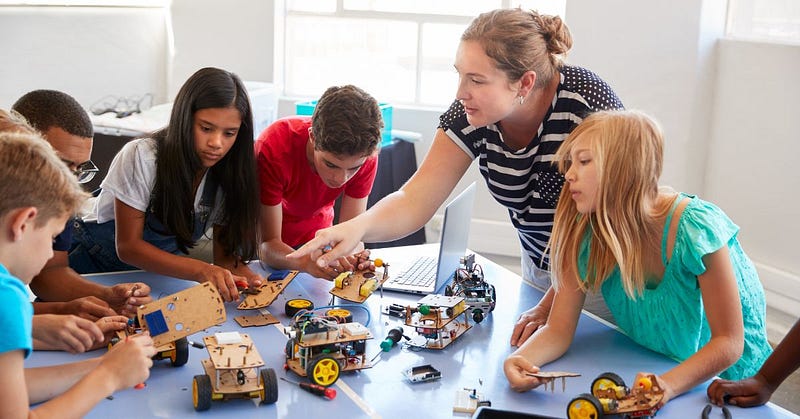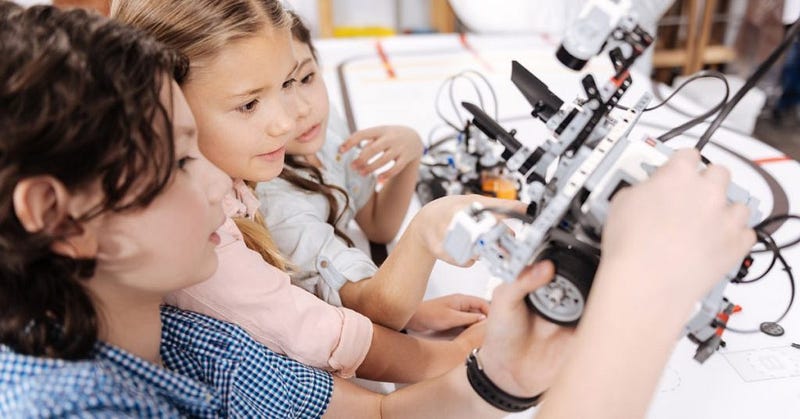5 Benefits of Teaching Robotics to Children
- Get link
- X
- Other Apps

Technology is evolving every day, and to keep up with the changing world, your kids need the knowledge and skills that prepare them for the future. Therefore, you must understand how learning robotics can help children grow academically and learn new skills. Robotics is a part of the new-age technology that has emerged, allowing humans with their day-to-day tasks.
Robotics has evolved into a significant development in almost every sphere. But, being a parent, you might have this specific question: Why should kids be taught robotics? What are the benefits of learning robotics for kids? So, before moving ahead with the help of teaching robotics to children, let us understand the general aspects of the two terms-robots, robotics, and their meaning.
Table of Contents
- What do you mean by a robot and robotics?
- 5 Benefits of Teaching Robotics to Children
- Encourages creativity and innovation
- Encourages goal setting
- Helps develops a critical cognitive mindset for kids
- Improves kids’ attention to detail
- Helps develop collaboration and communication skills
What do you mean by a robot and robotics?
A robot is a well-organised tool or entity that pursues instructions or information to take out specific movements. Certain robots are designed mainly for scientific and service objectives and can take out charges humans are incompetent to do. However, in numerous demanding settings, robots are set to operate. For instance, a study by McKinsey Global Institute discovered that up to 800 million global workers will be replaced by robotic automation by 2030. Such statistics show the future of the world in terms of robotics.
Robotics is an interdisciplinary domain of education, especially in engineering and science. It is devoted to constructing, maintaining, and using automated robots. Robots are programmable tools that mimic or assist humans in their daily movements. They were preferably designed to embark on repetitious exercises (like building vehicles on an assembly line). Yet, they have been used for numerous tasks, including battling blazes, grooming places, and helping with strongly complicated strategies.
5 Benefits of Teaching Robotics to Children
When your kids learn the basics of robotics at a younger age, it boosts their problem-solving and logical thinking abilities. Here are five benefits that come with teaching robotics to children:
Encourages creativity and innovation
The key to solving problems in the twenty-first century is to improve human and artificial mechanisms’ capacity to develop original and helpful ideas. In this learning process, kids often generate creative ideas, leading to new forms of innovation. Learning robotics, therefore, in a way, creates new outputs for the future. The robot creation process involves thinking of new ideas and processing and analysing. Kids may invent and construct fantastic machines and gadgets by exercising their creativity.
Encourages goal setting
The process of creating a robot involves many parts. A student sets goals in terms of the processes that need to be carried out while creating a robot. Hence, the process of creating a robot enables a student to learn about goal setting, which will be a helpful skill for a child to learn and utilise throughout their life.
Helps develops a critical cognitive mindset for kids
While working on robotics-related projects, kids come across the terms ‘problem’ and ‘solving.’ While trying to figure out these terms, kids gradually have a critical thinking mindset. This mindset not only helps in STEM course learning but also in overall academic advancement.
Along with this, a critical understanding of concepts helps students figure out problems with appropriate solutions. This process, in a way, allows kids to grow with an optimistic view and approach.
Improves kids’ attention to detail
While constructing robots, kids need to pay attention to small details. Hence, kids learn how to complete projects by focusing on every task that needs to be completed, right from when the project starts to when it ends. When kids learn robotics regularly, they will be able to improve their concentration level over time.
Helps develop collaboration and communication skills
Collaboration and communication skills are regarded as practical life skills that improve children’s performance in school, the workplace, and other settings. Therefore, children work together in robotics camps and classes to share knowledge and carry out the project as planned.
Often, making a robot doesn’t involve one hand. Instead, it requires teamwork and supervision skills, and a kid may need to interact with other students. Hence, the kids learn how to execute successful projects by efficiently interacting with each other.
Now that you know about these benefits of teaching robotics to children, we hope you are no longer stuck with the query of why kids should know robotics.
If you enjoyed reading this blog, you can also check out this blog, ‘’How to discover the best coding program for your kids.’’
- Get link
- X
- Other Apps
Comments
Post a Comment